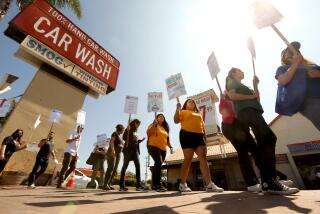Editorial: CalSavers will help keep retirees out of poverty. So why is a taxpayer group fighting it?

- Share via
By the rest of the world’s standards, Americans aren’t very good at saving money, and especially not at saving for their dotage. This week there were two important developments on that front: The state of California officially launched a good but controversial program to help lower-income workers build individual retirement accounts, and Republicans in the U.S. House of Representatives abandoned their own, bad idea for boosting saving.
The state’s program, called CalSavers, automatically creates tax-advantaged individual retirement accounts for workers whose employers do not provide pensions, 401(k) plans or other retirement benefits. There are about 7.5 million Californians with full-time jobs who fall into that category, typically in lower-paying jobs. According to state statistics, two-thirds of those employees work at small businesses, and two-thirds are people of color.
By making it considerably easier for those workers to sock away part of their paycheck before taxes are deducted, the program is designed to vastly increase the number of working-class Californians who will retire with more of a cushion than just a Social Security check. That’s a goal we all should share, not just because it would be good for those served by the program, but also because impoverished retirees often become dependent on taxpayer-funded programs.
Lawmakers shouldn’t let themselves be distracted from the very real issue of low retirement savings.
Nevertheless, a state organization that purportedly looks out for taxpayers — the Howard Jarvis Taxpayers Assn. — has challenged CalSavers. Under the state law that created the program, employers that don’t provide a retirement plan (one of which is the Howard Jarvis Taxpayers Assn.) have to alert their workers to CalSavers and, if the workers don’t opt out, automatically steer a percentage of their wages — 5% initially by default, although workers could choose to contribute more or less — into a CalSavers IRA. The association argues that the state program is preempted by the federal law governing retirement benefits that companies provide their workers, the Employee Retirement Income Security Act of 1974.
It’s the second time right-of-center interests have attacked CalSavers. The first was when congressional Republicans repealed guidelines adopted by the Obama administration that gave state and local governments the green light to create programs that, like CalSavers, automatically enroll workers into IRAs.
Congress’ action removed a legal shield for CalSavers, but it will still be up to the court to decide whether the program is preempted by ERISA. The federal judge in the case has focused on an existing exemption from ERISA for plans that are “completely voluntary,” and has asked whether a program that requires employers to automatically enroll workers unless they opt out could qualify for such an exemption. But that’s the wrong question. The federal law applies to employer-sponsored retirement benefit programs. CalSavers is sponsored by the state, and structured in a way that neither employers nor taxpayers will have any liability for workers’ accounts.
Besides, unlike pensions and 401(k) plans, IRAs are completely portable and independent of employers. Workers take their IRAs with them, unchanged, whenever they switch jobs. The challenge has been getting workers who aren’t covered by retirement plans to set up and invest in IRAs. According to AARP, people with access to a retirement savings plan at work are 15 times more likely to save. Add automatic enrollment to the program and participation rises even further.
Sure, there’s a nanny state element to CalSavers. Workers could certainly set up their own IRAs and receive the same tax breaks. But pooling them into statewide plans that are professionally managed steers them toward safer investments and cuts their fees, while adding a layer of oversight from state authorities.
That’s why CalSavers, which was championed by former Senate President Pro Tem Kevin de León (D-Los Angeles) and nurtured by Treasurer John Chiang, is an important part of the state’s antipoverty efforts. It’s in a pilot stage now with about 20 employers, but it is slated to be open to all eligible employers, employees, independent contractors and self-employed workers July 1.
Enter the Fray: First takes on the news of the minute from L.A. Times Opinion »
Meanwhile, the chairman of the House Ways and Means Committee, Kevin Brady (R-Texas), unveiled a package of tax-cut proposals Monday that he will push in Congress’ lame-duck session. Notably and thankfully missing was the House-passed proposal for Universal Savings Accounts, a harebrained scheme more likely to subsidize luxury car purchases than to help low-income retirees make ends meet.
Under the proposal, people could contribute a few thousand dollars of taxed income to a Universal Savings Account, invest it, watch it grow tax-free, then spend it on … anything they pleased, whenever they wanted. Unlike IRAs, there would be no tax penalty for withdrawing the money early, nor any barrier to high-income people participating. For people of means, who are likely to have retirement savings plans already, the Universal accounts would help subsidize consumption; for those with limited incomes, they could dangerously divert money away from retirement savings. The proposal was a solution in search of a problem; lawmakers shouldn’t let themselves be distracted from the very real issue of low retirement savings.
Follow the Opinion section on Twitter @latimesopinion and Facebook
More to Read
A cure for the common opinion
Get thought-provoking perspectives with our weekly newsletter.
You may occasionally receive promotional content from the Los Angeles Times.






